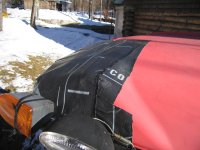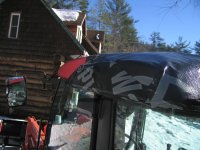fruitcakesa
Veteran Member
The tractor's not the shed's that is...first oops on the big[ger] machine
During an early season <15* spell of weather, I backed the new M into the driveshed roof, which was originally built for a JD 350 dozer and easily accommodated my L4630 but its max height above the M is only 2 inches so...
The entire left rear corner of the cab roof above the cabin filter exploded into many small shards of orange plastic.
I drove around with a plastic sheet stuffed into the breach, till I figured out my fix and had time and good weather to do it.
I cleaned out all the loose plastic pieces and then swabbed the entire area to be patched with rubbing alcohol.
I cut and fit a piece of bituthane roof patch large enough to bridge the gap and fold around the bottom edge of the roof to seal it well.
Using the industrial heat gun, ran it over the patch and roll it down on the roof
so that it adheres well and work your way over the entire patch, molding it into the irregularities of the roof and slicing the corners so they fold easily.
The roof plastic below the patch is non existent but the 2 layers of patch are pretty sturdy
Even in 20* temps, the patch stuck tight.
I put a second piece over the slices and seams and did the same sealing process.
It looks pretty good with the orange.


During an early season <15* spell of weather, I backed the new M into the driveshed roof, which was originally built for a JD 350 dozer and easily accommodated my L4630 but its max height above the M is only 2 inches so...
The entire left rear corner of the cab roof above the cabin filter exploded into many small shards of orange plastic.
I drove around with a plastic sheet stuffed into the breach, till I figured out my fix and had time and good weather to do it.
I cleaned out all the loose plastic pieces and then swabbed the entire area to be patched with rubbing alcohol.
I cut and fit a piece of bituthane roof patch large enough to bridge the gap and fold around the bottom edge of the roof to seal it well.
Using the industrial heat gun, ran it over the patch and roll it down on the roof
so that it adheres well and work your way over the entire patch, molding it into the irregularities of the roof and slicing the corners so they fold easily.
The roof plastic below the patch is non existent but the 2 layers of patch are pretty sturdy
Even in 20* temps, the patch stuck tight.
I put a second piece over the slices and seams and did the same sealing process.
It looks pretty good with the orange.


